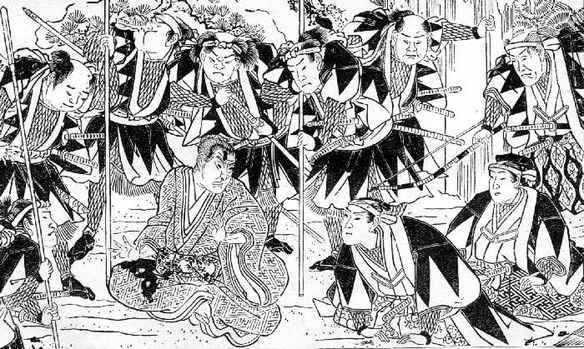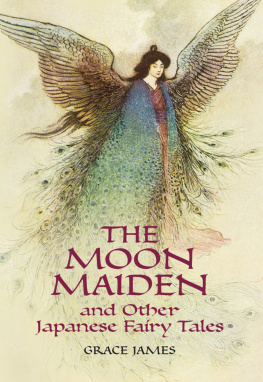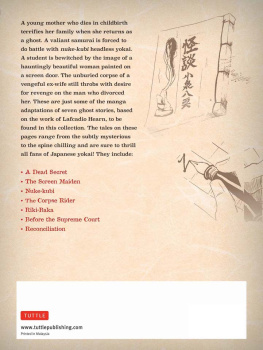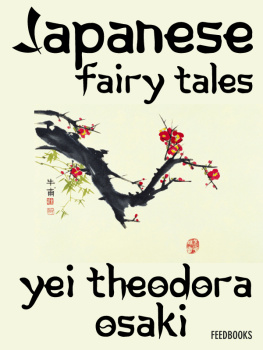The Project Gutenberg eBook, Tales of Old Japan, by Algernon Bertram Freeman-Mitford
This eBook is for the use of anyone anywhere at no cost and with
almost no restrictions whatsoever. You may copy it, give it away or
re-use it under the terms of the Project Gutenberg License included
with this eBook or online at www.gutenberg.net
Title: Tales of Old Japan
Author: Algernon Bertram Freeman-Mitford
Release Date: July 24, 2004 [eBook #13015]
Language: English
Character set encoding: ISO-8859-1
***START OF THE PROJECT GUTENBERG EBOOK TALES OF OLD JAPAN***
E-text prepared by Jonathan Ingram, Sandra Brown,
and the Project Gutenberg Online Distributed Proofreading Team
Note:
The author, Algernon Bertram Freeman-Mitford (1837-1916), Lord Redesdale, was in the British Foreign Service as a young man. He was assigned to the legation in Japan for several years and acquired a life-long fascination with Japanese culture. This book has been a standard source of information about Japanese folklore and customs since its original publication in 1871 and has been in print ever since.

THE RNINS INVITE KTSUK NO SUK TO PERFORM HARA-KIRI.
TALES OF OLD JAPAN
by
LORD REDESDALE, G.C.V.O., K.C.B.
FORMERLY SECOND SECRETARY TO THE BRITISH LEGATION IN JAPAN
WITH ILLUSTRATIONS
DRAWN AND CUT ON WOOD BY JAPANESE ARTISTS
1910
PREFACE
In the Introduction to the story of the Forty-seven Rnins, I have said almost as much as is needful by way of preface to my stories.
Those of my readers who are most capable of pointing out the many shortcomings and faults of my work, will also be the most indulgent towards me; for any one who has been in Japan, and studied Japanese, knows the great difficulties by which the learner is beset.
For the illustrations, at least, I feel that I need make no apology. Drawn, in the first instance, by one dak, an artist in my employ, they were cut on wood by a famous wood-engraver at Yedo, and are therefore genuine specimens of Japanese art. Messrs. Dalziel, on examining the wood blocks, pointed out to me, as an interesting fact, that the lines are cut with the grain of the wood, after the manner of Albert Drer and some of the old German masters,a process which has been abandoned by modern European wood-engravers.
It will be noticed that very little allusion is made in these Tales to the Emperor and his Court. Although I searched diligently, I was able to find no story in which they played a conspicuous part.
Another class to which no allusion is made is that of the Gshi. The Gshi are a kind of yeomen, or bonnet-lairds, as they would be called over the border, living on their own land, and owning no allegiance to any feudal lord. Their rank is inferior to that of the Samurai, or men of the military class, between whom and the peasantry they hold a middle place. Like the Samurai, they wear two swords, and are in many cases prosperous and wealthy men claiming a descent more ancient than that of many of the feudal Princes. A large number of them are enrolled among the Emperor's body-guard; and these have played a conspicuous part in the recent political changes in Japan, as the most conservative and anti-foreign element in the nation.
With these exceptions, I think that all classes are fairly represented in my stories.
The feudal system has passed away like a dissolving view before the eyes of those who have lived in Japan during the last few years. But when they arrived there it was in full force, and there is not an incident narrated in the following pages, however strange it may appear to Europeans, for the possibility and probability of which those most competent to judge will not vouch. Nor, as many a recent event can prove, have heroism, chivalry, and devotion gone out of the land altogether. We may deplore and inveigh against the Yamato Damashi, or Spirit of Old Japan, which still breathes in the soul of the Samurai, but we cannot withhold our admiration from the self-sacrifices which men will still make for the love of their country.
The first two of the Tales have already appeared in the Fortnightly Review, and two of the Sermons, with a portion of the Appendix on the subject of the Hara-Kiri, in the pages of the Cornhill Magazine. I have to thank the editors of those periodicals for permission to reprint them here.
LONDON, January 7, 1871.
CONTENTS
LIST OF ILLUSTRATIONS
THE FORTY-SEVEN RNINS
THE LOVES OF GOMPACHI AND KOMURASAKI
KAZUMA'S REVENGE
A STORY OF THE OTOKODAT OF YEDO
THE WONDERFUL ADVENTURES OF FUNAKOSHI JIUYMON
THE ETA MAIDEN AND THE HATAMOTO
FAIRY TALES
THE TONGUE-CUT SPARROW
THE ACCOMPLISHED AND LUCKY TEA-KETTLE
THE CRACKLING MOUNTAIN
THE STORY OF THE OLD MAN WHO MADE WITHERED TREES TO BLOSSOM
THE BATTLE OF THE APE AND THE CRAB
THE ADVENTURES OF LITTLE PEACHLING
THE FOXES' WEDDING
THE HISTORY OF SAKATA KINTOKI
THE ELVES AND THE ENVIOUS NEIGHBOUR
THE GHOST OF SAKURA
HOW TAJIMA SHUM WAS TORMENTED BY A DEVIL OF HIS OWN CREATION
CONCERNING CERTAIN SUPERSTITIONS
THE VAMPIRE CAT OF NABSHIMA
THE STORY OF THE FAITHFUL CAT
HOW A MAN WAS BEWITCHED AND HAD HIS HEAD SHAVED BY THE FOXES
THE GRATEFUL FOXES
THE BADGER'S MONEY
THE PRINCE AND THE BADGER
JAPANESE SERMONS
THE SERMONS OF KIU-, VOL. I. SERMON I.
THE SERMONS OF KIU-, VOL. I. SERMON II.
THE SERMONS OF KIU-, VOL. I. SERMON III.
APPENDICES:
AN ACCOUNT OF THE HARA-KIRI
THE MARRIAGE CEREMONY
ON THE BIRTH AND REARING OF CHILDREN
FUNERAL RITES
LIST OF ILLUSTRATIONS
THE RNINS INVITE RTSUK NO SUK TO PERFORM HARA-KIRI
THE WELL IN WHICH THE HEAD WAS WASHED
THE SATSUMA MAN INSULTS OISHI KURANOSUK
THE TOMBS OF THE RNINS
THE TOMB OF THE SHIYOKU
GOMPACHI AWAKENED BY THE MAIDEN IN THE ROBBERS' DEN
FORGING THE SWORD
MATAGOR KILLS YUKIY
THE DEATH OF DANYMON
TRICKS OF SWORDSMANSHIP AT ASAKUSA
THE DEATH OF CHBEI OF BANDZUIN
FUNAKOSHI JIUYMON ON BOARD THE PIRATE SHIP
JIUYMON PUNISHES HIS WIFE AND THE WRESTLER
FUNAKOSHI JIUYMON AND THE GOBLINS
"GOKUMON"
CHAMPION WRESTLER
A WRESTLING MATCH
GENZABUR'S MEETING WITH THE ETA MAIDEN
THE TONGUE-CUT SPARROW
THE TONGUE-CUT SPARROW (2)
THE ACCOMPLISHED AND LUCKY TEA-KETTLE
THE ACCOMPLISHED AND LUCKY TEA-KETTLE (2)
THE HARE AND THE BADGER
THE HARE AND THE BADGER (2)
THE OLD MAN WHO CAUSED WITHERED TREES TO FLOWER
THE OLD MAN WHO CAUSED WITHERED TREES TO FLOWER (2)
THE APE AND THE CRAB
THE APE AND THE CRAB (2)
LITTLE PEACHLING
LITTLE PEACHLING (2)
THE FOXES' WEDDING
THE FOXES' WEDDING (2)
THE DEPUTATION OF PEASANTS AT THEIR LORD'S GATE
THE GHOST OF SAKURA
SGOR THRUSTING THE PETITION INTO THE SHOGUN'S LITTER
THE CAT OF NABSHIMA
THE FEAST OF INARI SAMA
A JAPANESE SERMON
TALES OF OLD JAPAN
THE FORTY-SEVEN RNINS
The books which have been written of late years about Japan have either been compiled from official records, or have contained the sketchy impressions of passing travellers. Of the inner life of the Japanese the world at large knows but little: their religion, their superstitions, their ways of thought, the hidden springs by which they moveall these are as yet mysteries. Nor is this to be wondered at. The first Western men who came in contact with JapanI am speaking not of the old Dutch and Portuguese traders and priests, but of the diplomatists and merchants of eleven years agomet with a cold reception. Above all things, the native Government threw obstacles in the way of any inquiry into their language, literature, and history. The fact was that the Tycoon's Governmentwith whom alone, so long as the Mikado remained in seclusion in his sacred capital at Kito, any relations were maintainedknew that the Imperial purple with which they sought to invest their chief must quickly fade before the strong sunlight which would be brought upon it so soon as there should be European linguists capable of examining their books and records. No opportunity was lost of throwing dust in the eyes of the new-comers, whom, even in the most trifling details, it was the official policy to lead astray. Now, however, there is no cause for concealment; the












 THE RNINS INVITE KTSUK NO SUK TO PERFORM HARA-KIRI.
THE RNINS INVITE KTSUK NO SUK TO PERFORM HARA-KIRI.